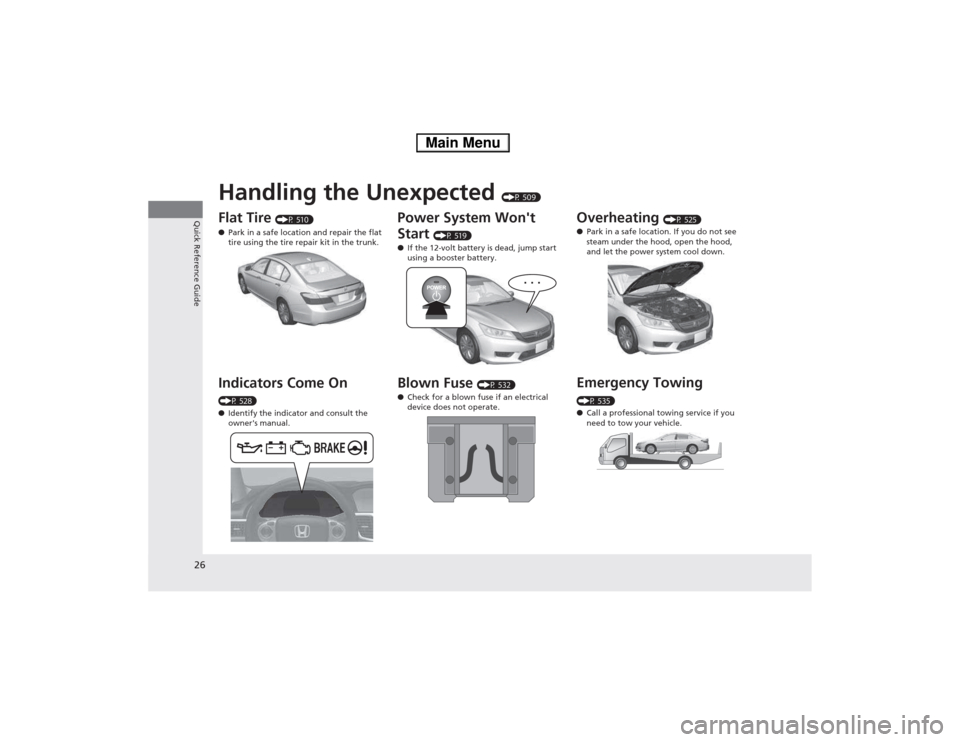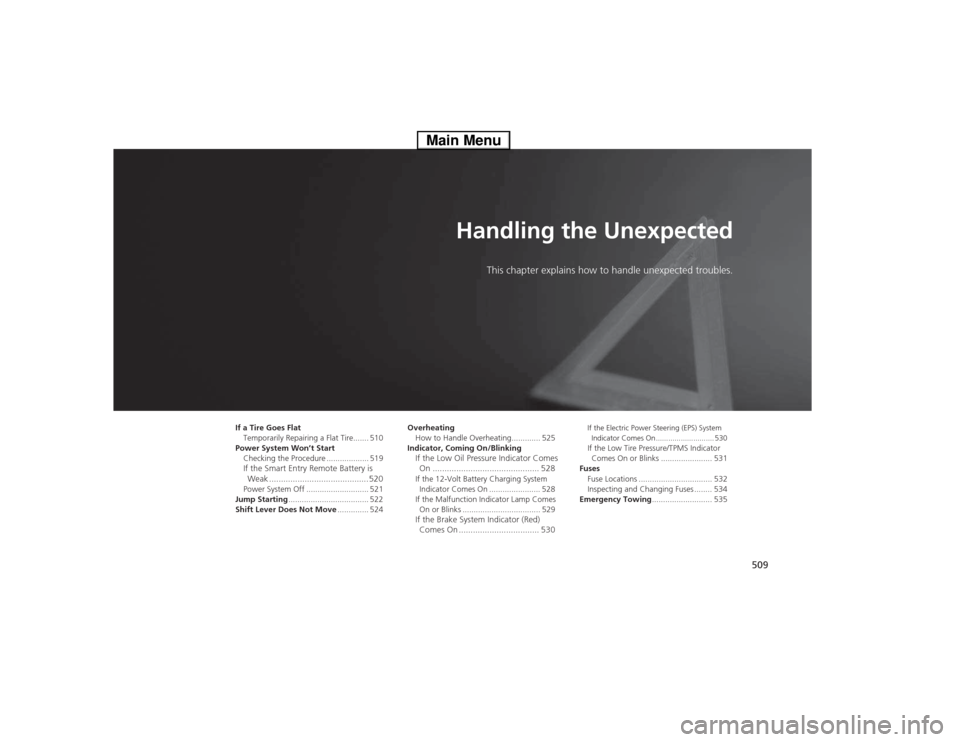2014 HONDA ACCORD HYBRID overheating
[x] Cancel search: overheatingPage 1 of 561

Contents
This owner’s manual should be considered a permanent part of the
vehicle and should remain with the vehicle when it is sold.
This owner’s manual covers all models of your vehicle. You may find
descriptions of equipment and features that are not on your
particular model.
Images throughout this owner’s manual (including the front cover)
represent features and equipment that are available on some, but
not all, models. Your particular model may not have some of these features.
This owner’s manual is for vehicles sold in the United States and Canada.
The information and specifications included in this publication were
in effect at the time of approval for printing. Honda Motor Co., Ltd.
reserves the right, however, to discontinue or change specifications
or design at any time without notice and without incurring any
obligation.2 Safe Driving P. 31For Safe Driving P. 32 Seat Belts P. 36 Airbags P. 43
2Instrument Panel P. 71Indicators P. 72 Gauges and Multi-Information Display P. 92
2Controls P. 109Clock P. 110 Locking and Unlocking the Doors P. 112
Opening and Closing the Moonroof *
P. 132
Adjusting the Seats P. 148
2 Features P. 169Audio System P. 170 Audio System Basic Operation P. 175, 197, 230
Customized Features P. 293 HomeLink ® Universal Transceiver *
P. 331
2 Driving P. 409Before Driving P. 410 Towing a Trailer P. 415
Refueling P. 459 Fuel Economy P. 461
2Maintenance P. 463Before Performing Maintenance P. 464 Maintenance Minder TM
P. 467
Checking and Maintaining Wiper Blades P. 491
Climate Control System Maintenance P. 504
2 Handling the Unexpected P. 509If a Tire Goes Flat P. 510 Power System Won’t Start P. 519
Overheating P. 525 Indicator, Coming On/Blinking P. 528
2Information P. 537Specifications P. 538 Identification Numbers P. 540
Emissions Testing P. 543 Warranty Coverages P. 545
Main Menu2014 ACCORD HYBRID Online Reference Owner's Manual
Page 27 of 561

26
Quick Reference Guide
Handling the Unexpected (P 509)
Flat Tire (P 510)
● Park in a safe location and repair the flat
tire using the tire repair kit in the trunk.
Indicators Come On
(P 528) ● Identify the indicator and consult the
owner's manual.
Power System Won't Start (P 519)
● If the 12-volt battery is dead, jump start
using a booster battery.
Blown Fuse (P 532)
● Check for a blown fuse if an electrical
device does not operate.Overheating (P 525)
● Park in a safe location. If you do not see
steam under the hood, open the hood,
and let the power system cool down.
Emergency Towing
(P 535) ● Call a professional towing service if you
need to tow your vehicle.
Main Menu
Page 85 of 561

84
uuIndicatorsuMulti-Information Display Warning and Information Messages
Instrument Panel
Multi-Information Display Warning and Information Messages
The following messages appear only on the multi-information display. Press the (information) button to see the message again
with the system message indicator on.
MessageConditionExplanation
● Appears when the fuel fill cap is loose or is not
installed.
2 Tighten Fuel Cap Message P. 529
●
Appears when the scheduled maintenance is due
soon.
uConsequently, Maintenance Due Now and
Maintenance Past Due follow.2Maintenance Minder Messages on the Multi-
Information Display P. 468
●
Appears when the engine coolant temperature gets
abnormally high.
2 Overheating P. 525
●
Appears when the engine coolant temperature is
near its upper limit.●Drive slowly to prevent overheating.
●
Appears if any door or the trunk is not completely closed.
● The beeper sounds and the message comes on if any
door or the trunk is opened while driving.●
Goes off when all doors and the trunk are closed.
Main MenuTable of Contents
Page 91 of 561

90
uuIndicatorsuMulti-Information Display Warning and Information Messages
Instrument Panel
MessageConditionExplanation
●
Appears when the washer fluid gets low.●Refill the washer fluid.
2Refilling Window Washer Fluid P. 483
●
Appears when the turn-by-turn direction comes on
the multi-information display.
2 Refer to the Navigation System Manual
●
Appears when the power system temperature is
high.●Your vehicle has less ability to accelerate and may be
harder to start on an incline.
● Park in a safe place, and cool the system down.
2Overheating P. 525
●
Appears when the High Voltage battery temperature is low.●Your vehicle has less ability to accelerate and may be
harder to start on an incline.
● Goes off once you start driving as the High Voltage
battery warms up.
●Appears after the 12-volt battery charging system
indicator comes on.●Your vehicle has less ability to accelerate and may be
harder to start on an incline.
● Contact a dealer immediately.
Canadian models
Main MenuTable of Contents
Page 494 of 561

493
Maintenance
Checking and Maintaining Tires
Checking Tires
To safely operate your vehicle, your tires must be of the proper type and size, in
good condition with adequate tread, and properly inflated. ■Inflation guidelines
Properly inflated tires provide the best combination of handling, tread life, and comfort. Refer to the driver’s doorjamb label or sp ecification’s page for the specified pressure.
Underinflated tires wear unevenly, adversely affect handling and fuel economy, and
are more likely to fail from overheating.
Overinflated tires make your vehicle ride harshly, are more prone to road hazards, and wear unevenly.
Every day before you drive, look at each of the tires. If one looks lower than the
others, check the pressure with a tire gauge.
At least once a month or before long trips, use a gauge to measure the pressure in
all tires. Even tires in good condition can lose 1 to 2 psi (10 to 20 kPa, 0.1 to 0.2
kgf/cm 2
) per month.
■ Inspection guidelines
Every time you check inflation, also examine the tires and valve stems.
Look for: • Bumps or bulges on the side or in the tread. Replace the tire if you find any cuts,
splits, or cracks in the side of the tire. Replace it if you see fabric or cord.
• Remove any foreign objects and inspect for air leaks.
• Uneven tread wear. Have a dealer check the wheel alignment.
• Excessive tread wear.
2 Wear Indicators P. 498
• Cracks or other damage around valve stem.
1Checking Tires
Measure the air pressure when tires are cold. This
means the vehicle has been parked for at least three
hours, or driven less than 1 mile (1.6 km). If
necessary, add or release air until the specified
pressure is reached.
If checked when hot, tire pressure can be as much as
4–6 psi (30–40 kPa, 0.3–0.4 kgf/cm 2
) higher than if
checked when cold.
Whenever tire pressure is adjusted, you must
calibrate the TPMS.
2 TPMS Calibration P. 447
Have a dealer check the tires if you feel a consistent
vibration while driving. New tires and any that have
been removed and reinstalled should be properly balanced.
3WARNING
Using tires that are excessively worn or
improperly inflated can cause a crash in
which you can be seriously hurt or killed.
Follow all instruction s in this owner’s
manual regarding tire inflation and
maintenance.
Main MenuTable of Contents
Page 510 of 561

509
Handling the UnexpectedThis chapter explains how to h andle unexpected troubles.
If a Tire Goes Flat
Temporarily Repairing a Flat Tire....... 510
Power System Won’t Start Checking the Procedure ................... 519
If the Smart Entry Remote Battery is
Weak ..........................................520
Power System Off ............................ 521
Jump Starting .................................... 522
Shift Lever Does Not Move .............. 524Overheating
How to Handle Overheating............. 525
Indicator, Coming On/Blinking If the Low Oil Pressure Indicator Comes
On ............................................. 528
If the 12-Volt Battery Charging System Indicator Comes On ....................... 528
If the Malfunction Indicator Lamp Comes On or Blinks ................................... 529
If the Brake System Indicator (Red)
Comes On .................................. 530 If the Electric Power Steering (EPS) System
Indicator Comes On............................ 530
If the Low Tire Pressure/TPMS Indicator Comes On or Blinks ....................... 531
Fuses Fuse Locations ................................. 532
Inspecting and Changing Fuses ........ 534
Emergency Towing ........................... 535
Main Menu
Page 526 of 561

525
Continued
Handling the Unexpected
Overheating
How to Handle Overheating
Overheating symptoms are as follows: •
The High Temperature. Power Reduced. message appears on the multi-
information display.
• The Engine Temperature Too Hot message appears on the multi-information
display.
• Steam or spray comes out of the engine compartment.
The High Temperature. Power Reduced. message appears on the multi-
information display when the power system temperature is high. 2 Multi-Information Display Warning and Information Messages P. 90
1. Immediately park the vehicle in a safe place.
uMove the shift lever to (P , and set the parking brake. Turn off all accessories
and turn on the hazard warning lights.
2. Keep the power mode on, and wait until the message disappears.
uIf the message does not disappear, have your vehicle inspected at a dealer.
■The High Temperature. Power Reduced. Message Appears
on the Multi-Information Display
Main MenuTable of Contents
Page 527 of 561

uuOverheatinguHow to Handle Overheating
526
Handling the Unexpected
■ First thing to do
1. Immediately park the vehicle in a safe place.
2. Turn off all accessories and turn on the hazard warning lights.
uNo steam or spray present: Keep the power system on and open the hood.uSteam or spray is present: Turn off the power system and wait until it
subsides. Then open the hood.
■The Engine Temperature Too Hot Message Appears on the
Multi-Information Display1The Engine Temperature Too Hot Message Appears on the Multi-Information Display
NOTICEContinuing to drive with the Engine Temperature
Too Hot message on the multi-information display
may damage the engine.
3WARNING
Steam and spray from an overheated
engine can seriously scald you.
Do not open the hood if steam is coming
out.
Main MenuTable of Contents